A Gentle Introduction to Bayesian Analysis with Applications to QuantCrit
A workshop to introduce quantitatively-trained researchers to the Bayesian paradigm with applications to QuantCrit
Welcome Setup Modules Resources About
Analytic Examples
In this part of the workshop, we’ll work through a couple of examples of a Bayesian analysis. The first will be a very simple regression and the second a more complex regression with deep interactions. We’ll also consider a few model checks and ways of presenting the results.
Because this workshop is short, we’ll end up focusing more on the technical aspects of Bayesian analyses than critical applications. One reason for this is the audience. We assume that participants at the ASHE conference have more exposure to critical theories and approaches, on average, than Bayesian statistics. As comparatively fewer people discuss Bayesian statistics at our conference or in our field, we focus on those aspects of a large topic. It is our hope that a solid introduction to the technical components of Bayes will allow participants to connect these tools to critical approaches, both in discussions and their own work. We will try to model this: our examples and discussion throughout will attempt to connect the technical aspects of Bayesian statistics to potential critical uses. That said, an ideal workshop would have more time to cover both components and we understand that other scholars may have chosen to focus differently than we have.
Libraries
We’ll load a few libraries for our analysis:
- tidyverse: useful for data wrangling
- brms: our main Bayesian regression tool
- bayesplot: support library for plotting Bayesian results
- tidybayes: support library for wrangling/plotting Bayesian results
- patchwork: combine plots
- shinystan: interactive inspection of Bayesian objects
- parallel: take advantage of multiple cores
If you don’t have these libraries, you can install them quickly with the following:
install.packages(c("tidyverse", "brms", "bayesplot", "tidybayes", "patchwork", "shinystan", "parallel"), dependencies = TRUE)
## ---------------------------
## libraries
## ---------------------------
libs <- c("tidyverse", "brms", "bayesplot", "tidybayes", "patchwork","shinystan")
sapply(libs, require, character.only = TRUE)
## Loading required package: tidyverse
## ── Attaching core tidyverse packages ──────────────────────── tidyverse 2.0.0 ──
## ✔ dplyr 1.1.4 ✔ readr 2.1.5
## ✔ forcats 1.0.0 ✔ stringr 1.5.1
## ✔ ggplot2 3.4.4 ✔ tibble 3.2.1
## ✔ lubridate 1.9.3 ✔ tidyr 1.3.1
## ✔ purrr 1.0.2
## ── Conflicts ────────────────────────────────────────── tidyverse_conflicts() ──
## ✖ dplyr::filter() masks stats::filter()
## ✖ dplyr::lag() masks stats::lag()
## ℹ Use the conflicted package (<http://conflicted.r-lib.org/>) to force all conflicts to become errors
## Loading required package: brms
##
## Loading required package: Rcpp
##
## Loading 'brms' package (version 2.20.4). Useful instructions
## can be found by typing help('brms'). A more detailed introduction
## to the package is available through vignette('brms_overview').
##
##
## Attaching package: 'brms'
##
##
## The following object is masked from 'package:stats':
##
## ar
##
##
## Loading required package: bayesplot
##
## This is bayesplot version 1.10.0
##
## - Online documentation and vignettes at mc-stan.org/bayesplot
##
## - bayesplot theme set to bayesplot::theme_default()
##
## * Does _not_ affect other ggplot2 plots
##
## * See ?bayesplot_theme_set for details on theme setting
##
##
## Attaching package: 'bayesplot'
##
##
## The following object is masked from 'package:brms':
##
## rhat
##
##
## Loading required package: tidybayes
##
##
## Attaching package: 'tidybayes'
##
##
## The following objects are masked from 'package:brms':
##
## dstudent_t, pstudent_t, qstudent_t, rstudent_t
##
##
## Loading required package: patchwork
##
## Loading required package: shinystan
##
## Loading required package: shiny
##
##
## This is shinystan version 2.6.0
## tidyverse brms bayesplot tidybayes patchwork shinystan
## TRUE TRUE TRUE TRUE TRUE TRUE
Settings
We have a couple of settings that will help us. First, we’ll take advantage of
our computers’ multiple cores with options(mc.cores=parallel::detectCores()).
Because the estimation of Bayesian models involve pseudorandom computational processes, we’ll set a seed so that we get the same results.
## ---------------------------
## settings
## ---------------------------
## set number of cores to use to speed things up
options(mc.cores=parallel::detectCores())
## set a seed so things stay the same
my_seed <- 20231118
Data
The data we’re using today is a simplified version of HSLS09. Observations with missing data have been dropped. We’re also not accounting for the weighting scheme used by NCES.
## ---------------------------
## input
## ---------------------------
df <- readRDS("college.RDS")
## ---------------------------
## show data set
## ---------------------------
df
## # A tibble: 17,202 × 7
## id gender raceeth birthyr pov185 region college
## <int> <chr> <chr> <int> <chr> <chr> <dbl>
## 1 10001 male white 1995 above midwest 1
## 2 10002 female white 1995 below northeast 1
## 3 10003 female blackaa 1995 above west 1
## 4 10004 female white 1995 above south 0
## 5 10005 male white 1995 above south 0
## 6 10007 female white 1994 above northeast 1
## 7 10008 male white 1994 above northeast 1
## 8 10009 male white 1995 above south 1
## 9 10012 female white 1995 above midwest 1
## 10 10013 male white 1995 above south 1
## # ℹ 17,192 more rows
Simple regression
As a first step, we’ll fit a regression of college attendance on a vector of ones (intercept only model). This will give us the average attendance across the full sample, with measure of uncertainty in the spread of the posterior distribution.
With Bayesian models, we have to be a little more particular with our
distributional assumptions. Since our outcomes fall into 0s and 1s, we should
use a Bernoulli
distribution with a logit
link function for our likelihood in the family argument:
We know our k values here (0 for no college attendance and 1 for attendance). Our unknown is p, the probability of attendance.
Running the model
## -----------------------------------------------------------------------------
## simple regression: intercept only (average college-going rate)
## -----------------------------------------------------------------------------
## likelihood of going to college
fit <- brm(college ~ 1,
data = df,
family = bernoulli("logit"),
seed = my_seed)
You should notice a few things. First, your model has to be compiled to a faster coding language. For short models, it can take longer to compile than to run, but for longer models, this isn’t the case. You can also save the models so that you don’t have recompile each time.
Once it starts to run, you’ll see a lot of information about leapfrog steps, chains, warm-ups, and samples. We’ll discuss some of these pieces and what they mean in just a bit, but first we’ll take a look at the summary statistics.
## show summary stats
summary(fit)
## Family: bernoulli
## Links: mu = logit
## Formula: college ~ 1
## Data: df (Number of observations: 17202)
## Draws: 4 chains, each with iter = 2000; warmup = 1000; thin = 1;
## total post-warmup draws = 4000
##
## Population-Level Effects:
## Estimate Est.Error l-95% CI u-95% CI Rhat Bulk_ESS Tail_ESS
## Intercept 1.12 0.02 1.08 1.15 1.00 1460 2073
##
## Draws were sampled using sampling(NUTS). For each parameter, Bulk_ESS
## and Tail_ESS are effective sample size measures, and Rhat is the potential
## scale reduction factor on split chains (at convergence, Rhat = 1).
The intercept value is approximately 1.12. Remembering that this is on the logit scale, we can covert this using an inverse logit transformation:
Logit
\[ln(\frac{p}{1-p})\]Inverse logit
\[\frac{1}{1 + e^{-x}}\]## helper function: inverse logit
inv_logit <- function(x) { 1 / (1 + exp(-x)) }
## convert intercept value to probability scale
inv_logit(1.12)
## [1] 0.7539887
Approximately 75% of the sample attended college at some point. We also have an
estimated error of approximately 0.02 (back on the log scale). So far, this
seems much like you may be used seeing after fitting frequentist models. But
what is Rhat, Bulk_ESS, and Tail_ESS? Further, what is the meaning of all
the information in the Draws?
A quick note on how we actually estimate the posterior
In applied Bayesian work, the posterior distribution, which is proportional to the prior multiplied by the likelihood distributions, often doesn’t have a closed form solution. This just means we can’t solve for the posterior using analytic methods (e.g., algebraic equations). Instead, we are forced to sample from the posterior and build an empirical distribution of our best guesses. This is easier said than done because, remember, we don’t know the answer.
Imagine I put you in a dark room and told you that I wanted you to be able to describe the space to me. I assume the floor generally slopes to a low point, so you’ll probably make your way there. That said, the room may have dips in the floor or weird corners. It also may be the size of a typical classroom or the size of a football field. And also, I don’t have infinite time or money for your to spend your time figuring it out. How do you explore the space in way that’s complete but also efficient?
This is basically the problem facing applied Bayesian work. With the advent of
modern computing, we have a number of approaches. We unfortunately don’t have
time to get into the nuances, benefits, and drawbacks of various samplers. The
main thing to know is that most make use of Markov chain Monte Carlo (MCMC)
chains and, as a result, return multiple “guesses” of our unknown parameters.
When we see the Estimate and Est.Error values in the results, these are
summary statistics of a full distribution of results.
Why multiple chains?: Let’s go back to the room. If you only have so much time to explore the room, where you start may influence where you explore. You may not find the low point in the floor or you may get stuck in a corner. How do I know you are giving me an accurate account of the room? But if you can start multiple times in multiple places and end with similar results, that feels like evidence you are describing the space, or at least the main features. This is the logic behind running multiple chains.
Let’s look at beginning of the chains with a trace plot, the first 50 samples:
## show trace of chains for intercept (our main parameter)
color_scheme_set("mix-blue-pink")
mcmc_trace(fit |> as_draws(inc_warmup = TRUE),
pars = "b_Intercept", n_warmup = 1000,
window = c(0, 50)) +
labs(
title = "Trace of posterior chains",
subtitle = "Draws: 0 to 50"
)
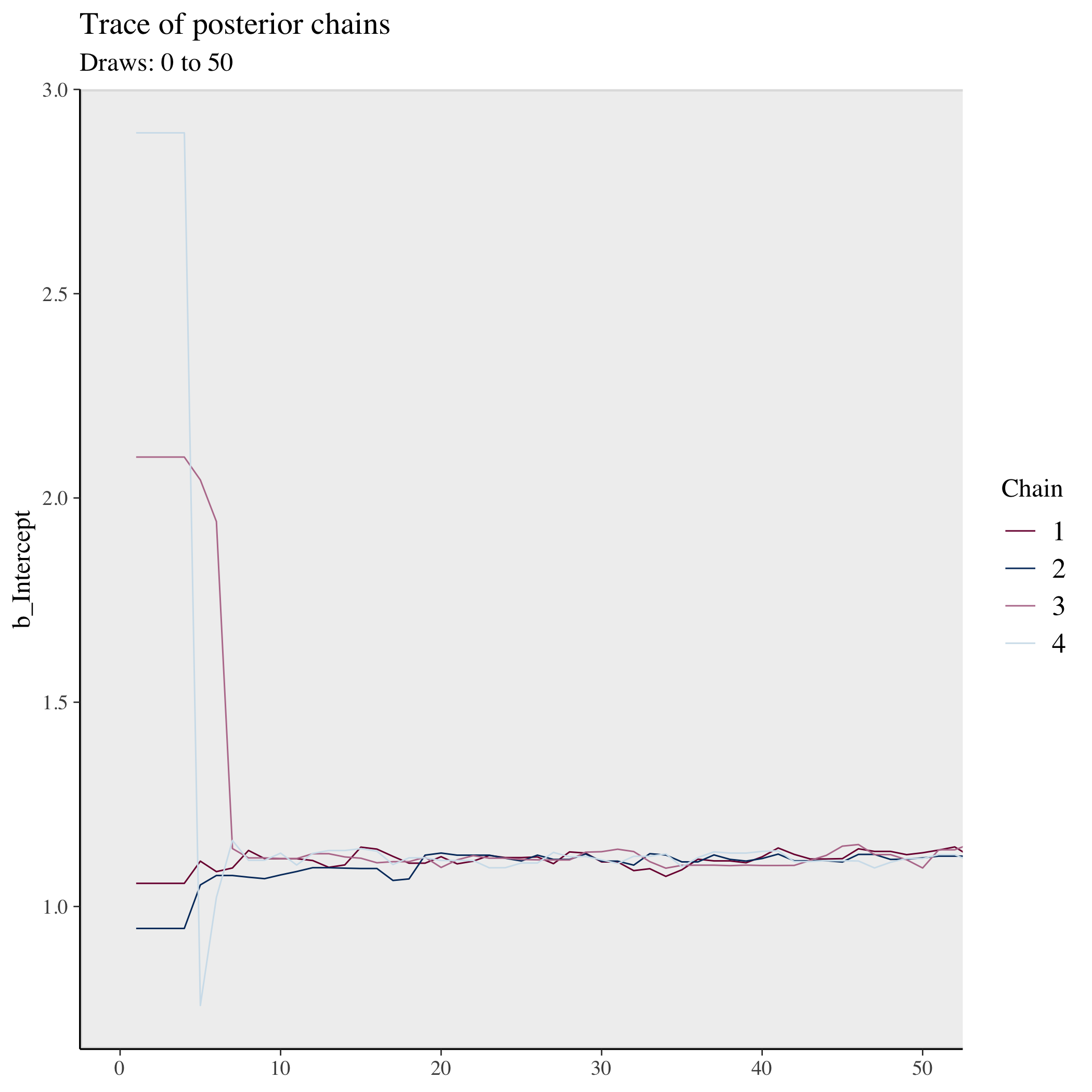
Notice how the four chains start in very different places. But very quickly for this simple model they collectively converge to a similar area. Let’s look at the rest of the samples:
## show trace of chains for intercept (our main parameter)
color_scheme_set("mix-blue-pink")
mcmc_trace(fit |> as_draws(inc_warmup = TRUE),
pars = "b_Intercept", n_warmup = 1000,
window = c(500, 2000)) +
labs(
title = "Trace of posterior chains",
subtitle = "Draws: 500 to 2000"
)
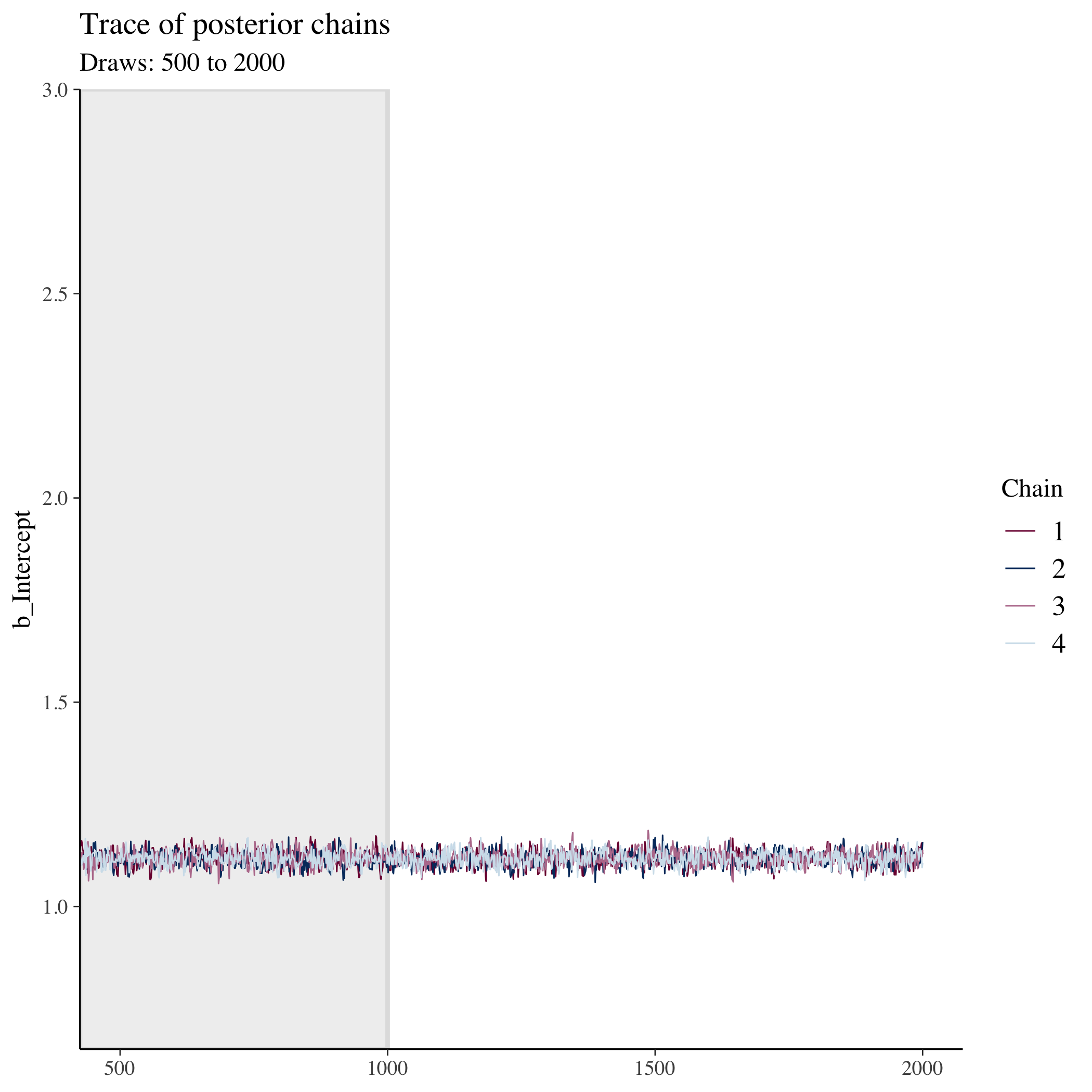
Because we purposefully start the chains in different spots, we shouldn’t think those early samples represent the posterior. We throw these out as warmup and only keep the later samples which are combined into our total post-warmup draws. In this model, we end up with 4,000 sample draws of our posterior.
Seeing the consistent overlap or mixing of the chains, we feel we have a
well-performing model (at least in terms of computation). The Rhat statistic
gives us a more formal test of the ratio of between chain variance to within
chain variance. Rhat measures below 1.1 suggest we have good mixture. The two
ESS measures stand for Effective Sample Size. Due to the deterministic
nature of our sampler (and most samplers), the draws in our sample distribution
aren’t entirely independent. Bulk_ESS sample size gives us the overall
effective sample size while Tail_ESS gives an estimate of effective sample
size in the tails of the distribution.
Plotting the posterior
Since our Bayesian posterior represents a distribution of samples, let’s look at it graphically.
## show distribution of intercept (our main parameter)
mcmc_areas(fit, prob = 0.95, pars = "b_Intercept") +
labs(
title = "Posterior distribution (log scale)",
subtitle = "with median and 95% interval"
)

As a quick trick, we’ll use the transformation argument and our inv_logit()
function to see the posterior on the probability scale.
## show distribution of transformed intercept (our main parameter)
## using helper function
mcmc_areas(fit, prob = 0.95, pars = "b_Intercept",
transformation = list("b_Intercept" = inv_logit)) +
labs(
title = "Posterior distribution (probability)",
subtitle = "with median and 95% interval; prior: student_t(0,3,2.5)"
)
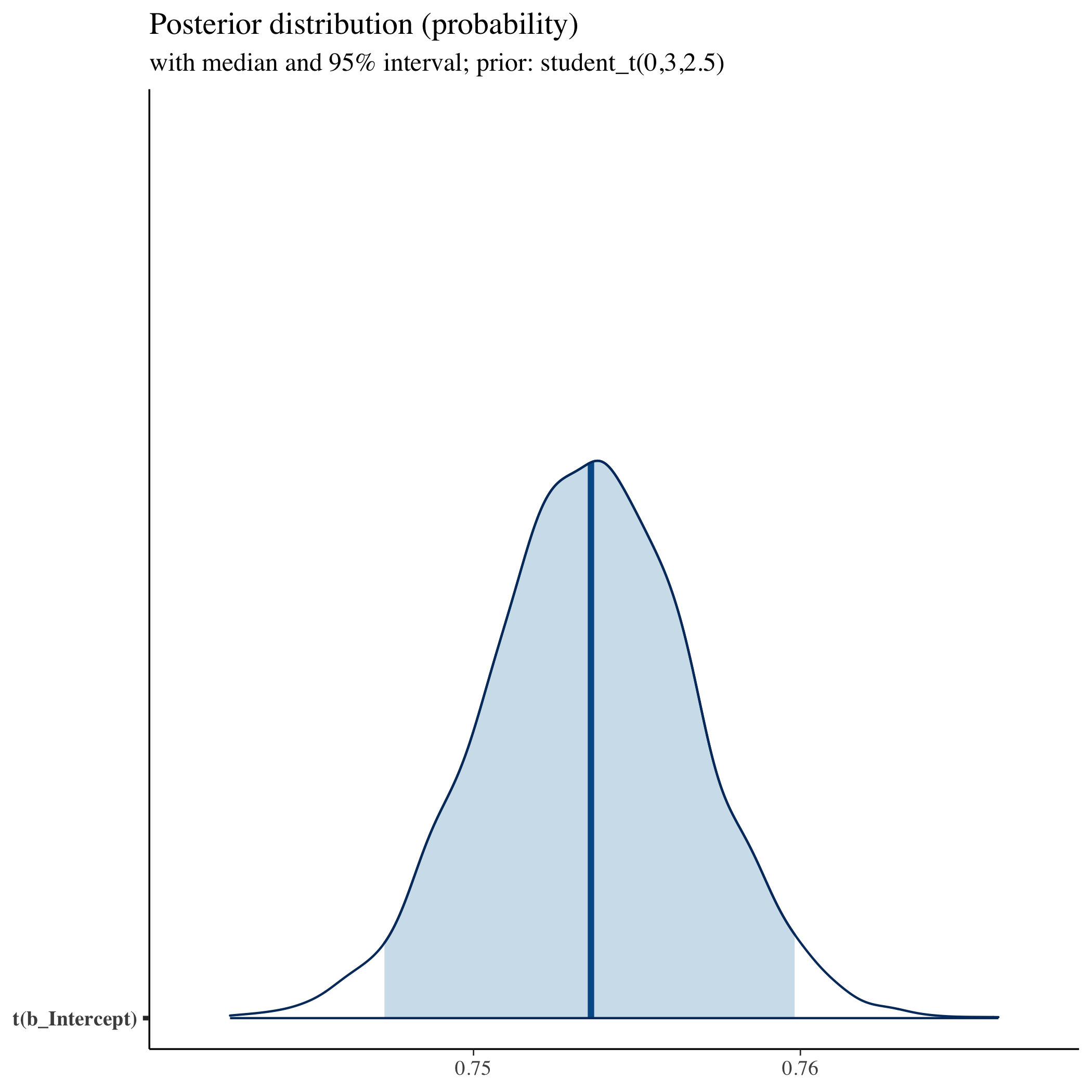
Priors
What about priors? Don’t we have to set those? By default, brm() will choose a
set of weakly informative priors based on the likelihood distribution you
set. You can check this after the fact using prior_summary().
## ---------------------------
## check prior
## ---------------------------
## show prior from first model
prior_summary(fit)
## Intercept ~ student_t(3, 0, 2.5)
Let’s change our prior to normal distribution with a wide variance (remember: we’re on a logit scale).
## change to normal prior for comparison
fit <- brm(college ~ 1,
data = df,
family = bernoulli("logit"),
seed = my_seed,
prior = set_prior("normal(0,20)", class = "Intercept"))
## Compiling Stan program...
## Start sampling
## check prior
prior_summary(fit)
## Intercept ~ normal(0,20)
## show summary stats
summary(fit)
## Family: bernoulli
## Links: mu = logit
## Formula: college ~ 1
## Data: df (Number of observations: 17202)
## Draws: 4 chains, each with iter = 2000; warmup = 1000; thin = 1;
## total post-warmup draws = 4000
##
## Population-Level Effects:
## Estimate Est.Error l-95% CI u-95% CI Rhat Bulk_ESS Tail_ESS
## Intercept 1.12 0.02 1.08 1.15 1.00 1498 2192
##
## Draws were sampled using sampling(NUTS). For each parameter, Bulk_ESS
## and Tail_ESS are effective sample size measures, and Rhat is the potential
## scale reduction factor on split chains (at convergence, Rhat = 1).
## show distribution of transformed intercept (our main parameter)
## using helper function
mcmc_areas(fit, prob = 0.95, pars = "b_Intercept",
transformation = list("b_Intercept" = inv_logit)) +
labs(
title = "Posterior distribution (probability)",
subtitle = "with median and 95% interval; prior: normal(0,20)",
)
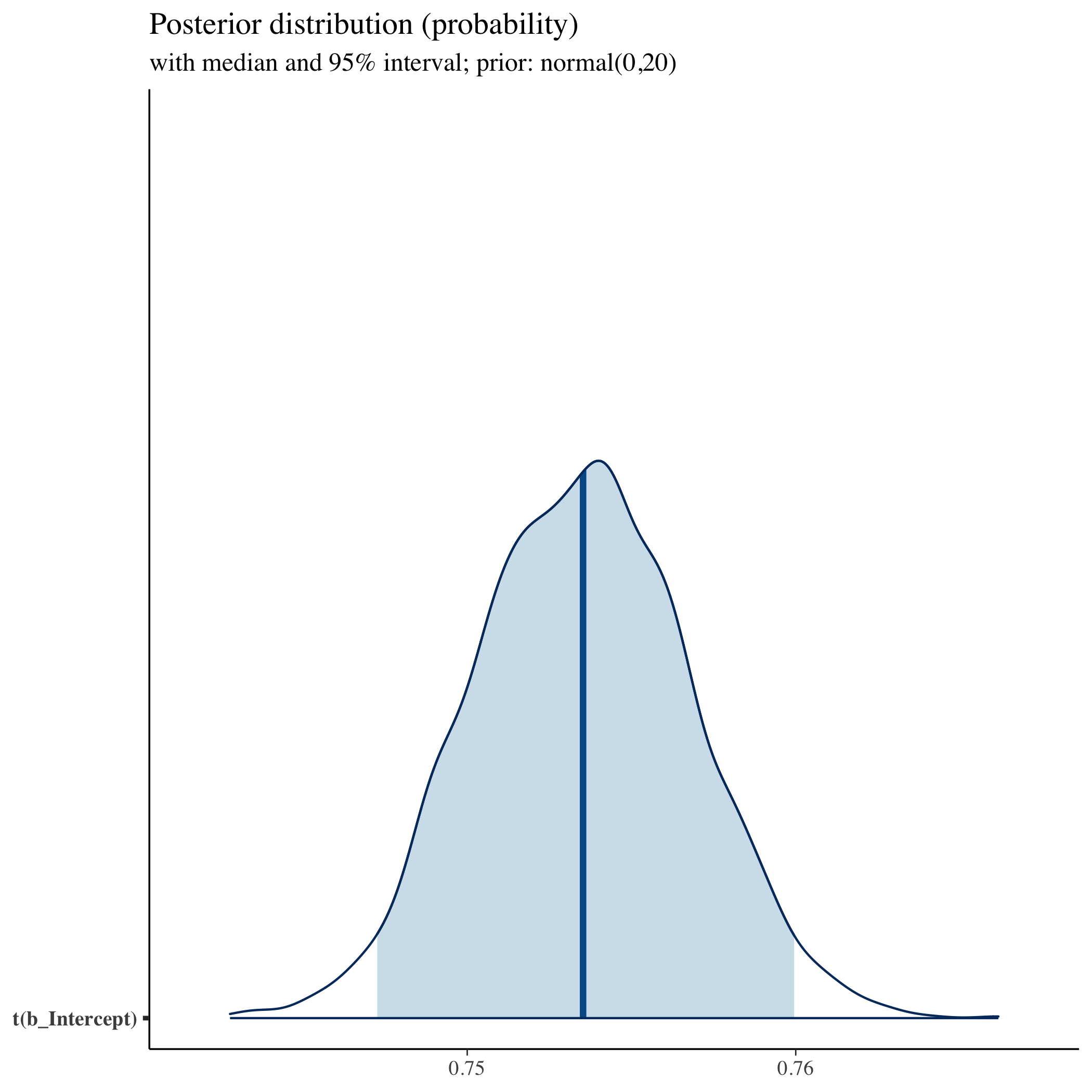
The posterior is largely the same. It may have taken slightly longer or shorter to run the sampler, but again, for this model it’s almost imperceptible. For more complex models, however, prior selection can be the difference between a model that converges and one that doesn’t. You can also be more specific with your priors. But for now, we’ll keep using the defaults.
Posterior check
Bayesians often talk about accurately modeling the data generating process. You can think about your model being a machine that, if accurately built and tuned, can be reversed to make predictions (new data) that look like what you observed. If posterior predictions look quite different from what you observed in your data, that’s evidence you don’t have a good model of the world that produced your data.
We can check this by producing a number of predictions from our fitted model
using posterior_epred() and comparing it to our empirical mean of college
enrollment.
## ---------------------------
## posterior predictive check
## ---------------------------
## plot our posterior predictive values against the college-going rate
## that is observed in the data
ppc_stat(y = df |> pull(college) |> c(),
yrep = posterior_epred(fit),
stat = mean)
## `stat_bin()` using `bins = 30`. Pick better value with `binwidth`.

Seeing that the distribution of our predictions $y^{rep}$ splits $y$, we have evidence that our machine/model is well specified.
Speed up trick
An unfortunate thing about Bayesian samplers is that they don’t scale well with data size. In some cases — such as our own — we can exploit connections between distributions and sufficient statistics to make our data matrix smaller and therefore sampler faster.
A Bernoulli distribution (coin flip) can be thought of a binomial distribution (successes out of trials) in which there is only one trial. By collapsing our data to a single row of the number of students who went to college out of the total, we can rewrite our model and speed it up.
## -----------------------------------------------------------------------------
## speed up trick
## -----------------------------------------------------------------------------
## since we're using categorical variables (rather than continuous variables),
## collapse binary data (bernoulli) into smaller data set of successes/trials
## (binomial) to take advantage of sufficient statistics
df_tmp <- df |>
summarise(college = sum(college),
n = n())
## likelihood of going to college using binomial
fit <- brm(college | trials(n) ~ 1,
data = df_tmp,
family = binomial("logit"),
seed = my_seed)
## Compiling Stan program...
## Start sampling
## show summary stats
summary(fit)
## Family: binomial
## Links: mu = logit
## Formula: college | trials(n) ~ 1
## Data: df_tmp (Number of observations: 1)
## Draws: 4 chains, each with iter = 2000; warmup = 1000; thin = 1;
## total post-warmup draws = 4000
##
## Population-Level Effects:
## Estimate Est.Error l-95% CI u-95% CI Rhat Bulk_ESS Tail_ESS
## Intercept 1.12 0.02 1.08 1.15 1.00 1470 2058
##
## Draws were sampled using sampling(NUTS). For each parameter, Bulk_ESS
## and Tail_ESS are effective sample size measures, and Rhat is the potential
## scale reduction factor on split chains (at convergence, Rhat = 1).
As we can see, we get the same results. We’ll use this speed up trick with our more complex model below.
Multiple regression model with deep interactions
In this model, we’ll interact our categorical indicators for race/ethnicity, gender, and poverty status. We’ll include main effects for each characteristic individually, but also random intercept adjustments for interactions for each group. These random effects will be especially important for providing estimates for small groups, which is one important aspect of QuantCrit — that we do not drop or overly aggregate small groups, thereby flattening heterogeneity of experience merely for reasons of statistical convenience.
## -----------------------------------------------------------------------------
## multiple regression across groups
## -----------------------------------------------------------------------------
## collapse into groups of race/ethnicity by gender by poverty level
df_tmp <- df |>
group_by(raceeth, gender, pov185) |>
summarise(college = sum(college),
n = n(),
.groups = "drop")
## likelihood of going to college using binomial
fit <- brm(college | trials(n) ~ raceeth + gender + pov185 +
(1 | raceeth:gender:pov185),
data = df_tmp,
family = binomial("logit"),
seed = my_seed)
## Compiling Stan program...
## Start sampling
## show summary stats
summary(fit)
## Family: binomial
## Links: mu = logit
## Formula: college | trials(n) ~ raceeth + gender + pov185 + (1 | raceeth:gender:pov185)
## Data: df_tmp (Number of observations: 52)
## Draws: 4 chains, each with iter = 2000; warmup = 1000; thin = 1;
## total post-warmup draws = 4000
##
## Group-Level Effects:
## ~raceeth:gender:pov185 (Number of levels: 52)
## Estimate Est.Error l-95% CI u-95% CI Rhat Bulk_ESS Tail_ESS
## sd(Intercept) 0.11 0.04 0.04 0.18 1.00 1227 1350
##
## Population-Level Effects:
## Estimate Est.Error l-95% CI u-95% CI Rhat Bulk_ESS Tail_ESS
## Intercept 1.46 0.20 1.07 1.85 1.01 897 1672
## raceethasian 1.76 0.22 1.33 2.18 1.00 987 1770
## raceethblackaa 0.47 0.21 0.07 0.87 1.01 895 1654
## raceethhispnr 0.40 0.24 -0.07 0.88 1.00 1087 1751
## raceethhisprs 0.48 0.21 0.07 0.88 1.00 883 1659
## raceethmoretor 0.59 0.21 0.18 1.01 1.00 915 1751
## raceethnhpi 0.26 0.35 -0.42 0.94 1.00 1734 2363
## raceethunknown 0.99 0.23 0.54 1.45 1.00 1058 1940
## raceethwhite 0.50 0.20 0.11 0.89 1.00 879 1621
## gendermale -0.48 0.06 -0.59 -0.37 1.00 3266 2836
## pov185below -1.21 0.07 -1.35 -1.07 1.00 2358 2897
## pov185unknown -1.30 0.07 -1.44 -1.15 1.00 2449 2286
##
## Draws were sampled using sampling(NUTS). For each parameter, Bulk_ESS
## and Tail_ESS are effective sample size measures, and Rhat is the potential
## scale reduction factor on split chains (at convergence, Rhat = 1).
Shiny Stan
A wonderful tool for inspecting our model fit is Shiny Stan. It performs many of the checks we performed before plus many more in an interactive browser window. To open the program, type the following on the console line:
launch_shinystan(fit)
Predictions
To make these marginal effect estimates easier to interpret, we’ll produce posterior predictions again. One thing that’s very easy to do with a model like this is make predictions — with appropriate measures of uncertainty included — even for groups that aren’t observed in the data. To do that, we will make a design matrix that includes all possible combinations of the demographic characteristics we modeled. In this way, we attend to another important dimension of QuantCrit work: that groups have their unique experiences represented.
After producing group-specific estimates, we’ll produce a plot showing the posterior predictions for each.
## ---------------------------
## posterior predictions
## ---------------------------
## create a design matrix (data frame) of all possible groups in our model
df_design <- expand.grid(raceeth = df |> distinct(raceeth) |> pull() |> c(),
gender = df |> distinct(gender) |> pull() |> c(),
pov185 = df |> distinct(pov185) |> pull() |> c(),
stringsAsFactors = FALSE) |>
as_tibble() |>
arrange(raceeth, gender, pov185) |>
mutate(n = 100,
group = paste(raceeth, gender, pov185, sep = "_"))
## get posterior predictions but in long form that's better for plotting
pp <- df_design |>
add_epred_draws(fit,
ndraws = 500,
allow_new_levels = TRUE)
## compute mean posterior by group to get order for plot
pp_mean <- pp |>
summarise(pp_mean = mean(.epred),
.groups = "drop") |>
arrange(pp_mean) |>
mutate(plot_index = row_number(),
plot_index = factor(plot_index,
levels = plot_index,
labels = group)) |>
select(group, pp_mean, plot_index)
## join means back to main pp tibble and plot densities for each group
bayes_g <- pp |>
left_join(pp_mean, by = "group") |>
ggplot(aes(y = plot_index, x = .epred)) +
stat_pointinterval(.width = 0.95, linewidth = 0.7, size = 1) +
scale_x_continuous(breaks = seq(0, 100, 10),
minor_breaks = seq(0, 100, 5)) +
labs(
title = "Posterior predictive distributions of college enrollment",
y = "Group: race/ethnicity + gender + poverty status (185%)",
x = "Rate of college attendance"
) +
theme_bw()
bayes_g

Compare to frequentist analysis
Inevitably, we (or a reviewer!) will want a comparison with a frequentist model. I will tell you know that this is a fool’s errand full of philosophical, statistical, and computational pitfalls and incommensurabilities. But nonetheless, let’s see how this sort of analysis might look in a frequentist model (as close as we can approximate anyway).
## -----------------------------------------------------------------------------
## quick comparison to frequentist approach
## -----------------------------------------------------------------------------
## fit logit model
lm_fit <- glm(cbind(college, n - college) ~ raceeth * gender * pov185,
data = df_tmp,
family = binomial("logit"))
## show summary
summary(lm_fit)
##
## Call:
## glm(formula = cbind(college, n - college) ~ raceeth * gender *
## pov185, family = binomial("logit"), data = df_tmp)
##
## Coefficients: (2 not defined because of singularities)
## Estimate Std. Error z value Pr(>|z|)
## (Intercept) 2.079e+00 7.500e-01 2.773 0.00556
## raceethasian 1.048e+00 7.923e-01 1.323 0.18598
## raceethblackaa -2.652e-01 7.674e-01 -0.346 0.72965
## raceethhispnr -9.808e-01 1.377e+00 -0.712 0.47625
## raceethhisprs -1.215e-01 7.628e-01 -0.159 0.87345
## raceethmoretor -1.515e-01 7.657e-01 -0.198 0.84311
## raceethnhpi 6.931e-01 1.275e+00 0.544 0.58661
## raceethunknown 2.182e+01 6.648e+04 0.000 0.99974
## raceethwhite 3.918e-02 7.524e-01 0.052 0.95847
## gendermale -1.192e+00 8.742e-01 -1.364 0.17265
## pov185below -2.166e+00 8.583e-01 -2.524 0.01160
## pov185unknown -1.520e+00 9.774e-01 -1.555 0.11996
## raceethasian:gendermale 8.133e-01 9.381e-01 0.867 0.38596
## raceethblackaa:gendermale 8.365e-01 9.006e-01 0.929 0.35299
## raceethhispnr:gendermale 1.480e+00 1.650e+00 0.897 0.36979
## raceethhisprs:gendermale 4.404e-01 8.932e-01 0.493 0.62200
## raceethmoretor:gendermale 7.120e-01 8.980e-01 0.793 0.42785
## raceethnhpi:gendermale 2.654e-01 1.487e+00 0.178 0.85841
## raceethunknown:gendermale 7.526e-01 8.025e-01 0.938 0.34831
## raceethwhite:gendermale 5.916e-01 8.775e-01 0.674 0.50022
## raceethasian:pov185below 1.409e+00 9.413e-01 1.496 0.13453
## raceethblackaa:pov185below 1.123e+00 8.815e-01 1.274 0.20261
## raceethhispnr:pov185below 1.132e+00 1.483e+00 0.764 0.44512
## raceethhisprs:pov185below 9.822e-01 8.745e-01 1.123 0.26142
## raceethmoretor:pov185below 1.122e+00 8.851e-01 1.268 0.20490
## raceethnhpi:pov185below -1.453e+00 1.508e+00 -0.964 0.33528
## raceethunknown:pov185below -4.614e+01 1.036e+05 0.000 0.99964
## raceethwhite:pov185below 6.669e-01 8.632e-01 0.773 0.43980
## raceethasian:pov185unknown 7.653e-03 1.027e+00 0.007 0.99405
## raceethblackaa:pov185unknown 2.307e-01 9.991e-01 0.231 0.81735
## raceethhispnr:pov185unknown 1.250e+00 1.528e+00 0.818 0.41338
## raceethhisprs:pov185unknown 1.244e-01 9.953e-01 0.125 0.90053
## raceethmoretor:pov185unknown 4.557e-01 1.006e+00 0.453 0.65060
## raceethnhpi:pov185unknown -7.419e-01 1.597e+00 -0.465 0.64228
## raceethunknown:pov185unknown -2.125e+01 6.648e+04 0.000 0.99974
## raceethwhite:pov185unknown 1.104e-01 9.823e-01 0.112 0.91055
## gendermale:pov185below 1.279e+00 1.058e+00 1.209 0.22683
## gendermale:pov185unknown 1.348e-02 1.173e+00 0.011 0.99083
## raceethasian:gendermale:pov185below -1.368e+00 1.174e+00 -1.165 0.24391
## raceethblackaa:gendermale:pov185below -1.401e+00 1.093e+00 -1.281 0.20012
## raceethhispnr:gendermale:pov185below -1.161e+00 1.821e+00 -0.638 0.52363
## raceethhisprs:gendermale:pov185below -9.009e-01 1.082e+00 -0.832 0.40522
## raceethmoretor:gendermale:pov185below -1.334e+00 1.100e+00 -1.213 0.22496
## raceethnhpi:gendermale:pov185below 4.949e-01 1.856e+00 0.267 0.78974
## raceethunknown:gendermale:pov185below NA NA NA NA
## raceethwhite:gendermale:pov185below -1.245e+00 1.066e+00 -1.168 0.24290
## raceethasian:gendermale:pov185unknown 4.412e-02 1.246e+00 0.035 0.97175
## raceethblackaa:gendermale:pov185unknown -5.135e-03 1.207e+00 -0.004 0.99661
## raceethhispnr:gendermale:pov185unknown -1.221e+00 1.851e+00 -0.659 0.50959
## raceethhisprs:gendermale:pov185unknown 3.401e-01 1.201e+00 0.283 0.77710
## raceethmoretor:gendermale:pov185unknown 2.999e-03 1.216e+00 0.002 0.99803
## raceethnhpi:gendermale:pov185unknown -2.907e-01 2.204e+00 -0.132 0.89508
## raceethunknown:gendermale:pov185unknown NA NA NA NA
## raceethwhite:gendermale:pov185unknown 1.494e-01 1.181e+00 0.127 0.89931
##
## (Intercept) **
## raceethasian
## raceethblackaa
## raceethhispnr
## raceethhisprs
## raceethmoretor
## raceethnhpi
## raceethunknown
## raceethwhite
## gendermale
## pov185below *
## pov185unknown
## raceethasian:gendermale
## raceethblackaa:gendermale
## raceethhispnr:gendermale
## raceethhisprs:gendermale
## raceethmoretor:gendermale
## raceethnhpi:gendermale
## raceethunknown:gendermale
## raceethwhite:gendermale
## raceethasian:pov185below
## raceethblackaa:pov185below
## raceethhispnr:pov185below
## raceethhisprs:pov185below
## raceethmoretor:pov185below
## raceethnhpi:pov185below
## raceethunknown:pov185below
## raceethwhite:pov185below
## raceethasian:pov185unknown
## raceethblackaa:pov185unknown
## raceethhispnr:pov185unknown
## raceethhisprs:pov185unknown
## raceethmoretor:pov185unknown
## raceethnhpi:pov185unknown
## raceethunknown:pov185unknown
## raceethwhite:pov185unknown
## gendermale:pov185below
## gendermale:pov185unknown
## raceethasian:gendermale:pov185below
## raceethblackaa:gendermale:pov185below
## raceethhispnr:gendermale:pov185below
## raceethhisprs:gendermale:pov185below
## raceethmoretor:gendermale:pov185below
## raceethnhpi:gendermale:pov185below
## raceethunknown:gendermale:pov185below
## raceethwhite:gendermale:pov185below
## raceethasian:gendermale:pov185unknown
## raceethblackaa:gendermale:pov185unknown
## raceethhispnr:gendermale:pov185unknown
## raceethhisprs:gendermale:pov185unknown
## raceethmoretor:gendermale:pov185unknown
## raceethnhpi:gendermale:pov185unknown
## raceethunknown:gendermale:pov185unknown
## raceethwhite:gendermale:pov185unknown
## ---
## Signif. codes: 0 '***' 0.001 '**' 0.01 '*' 0.05 '.' 0.1 ' ' 1
##
## (Dispersion parameter for binomial family taken to be 1)
##
## Null deviance: 1.6327e+03 on 51 degrees of freedom
## Residual deviance: 2.8359e-10 on 0 degrees of freedom
## AIC: 350.1
##
## Number of Fisher Scoring iterations: 22
## generage response predictions (meaning transform to probability scale)
lm_pred <- predict(lm_fit,
newdata = df_design,
se.fit = TRUE,
type = "response")
## Warning in predict.lm(object, newdata, se.fit, scale = residual.scale, type =
## if (type == : prediction from rank-deficient fit; attr(*, "non-estim") has
## doubtful cases
## wrangle data and join plot_index from Bayes plot so everything aligns; plot
## means and 95 CIs to match prior plot
freq_g <- tibble(group = df_design$group,
pred = lm_pred$fit * 100,
se = lm_pred$se.fit * 100) |>
mutate(ci95lo = pred + se * qnorm(0.025),
ci95hi = pred + se * qnorm(0.975)) |>
left_join(pp_mean, by = "group") |>
ggplot(aes(y = plot_index, x = pred)) +
geom_linerange(aes(xmin = ci95lo, xmax = ci95hi)) +
geom_point(aes(x = pred)) +
scale_x_continuous(breaks = seq(0, 100, 10),
minor_breaks = seq(0, 100, 5)) +
annotate("rect", xmin = -Inf, xmax = 0, ymin = 0, ymax = Inf, alpha = 0.1) +
annotate("rect", xmin = 100, xmax = Inf, ymin = 0, ymax = Inf, alpha = 0.1) +
labs(
title = "Frequentist predictions of college enrollment",
y = "Group: race/ethnicity + gender + poverty status (185%)",
x = "Rate of college attendance"
) +
theme_bw()
## use patchwork to compare figures
freq_g / bayes_g &
theme_bw(base_size = 6)
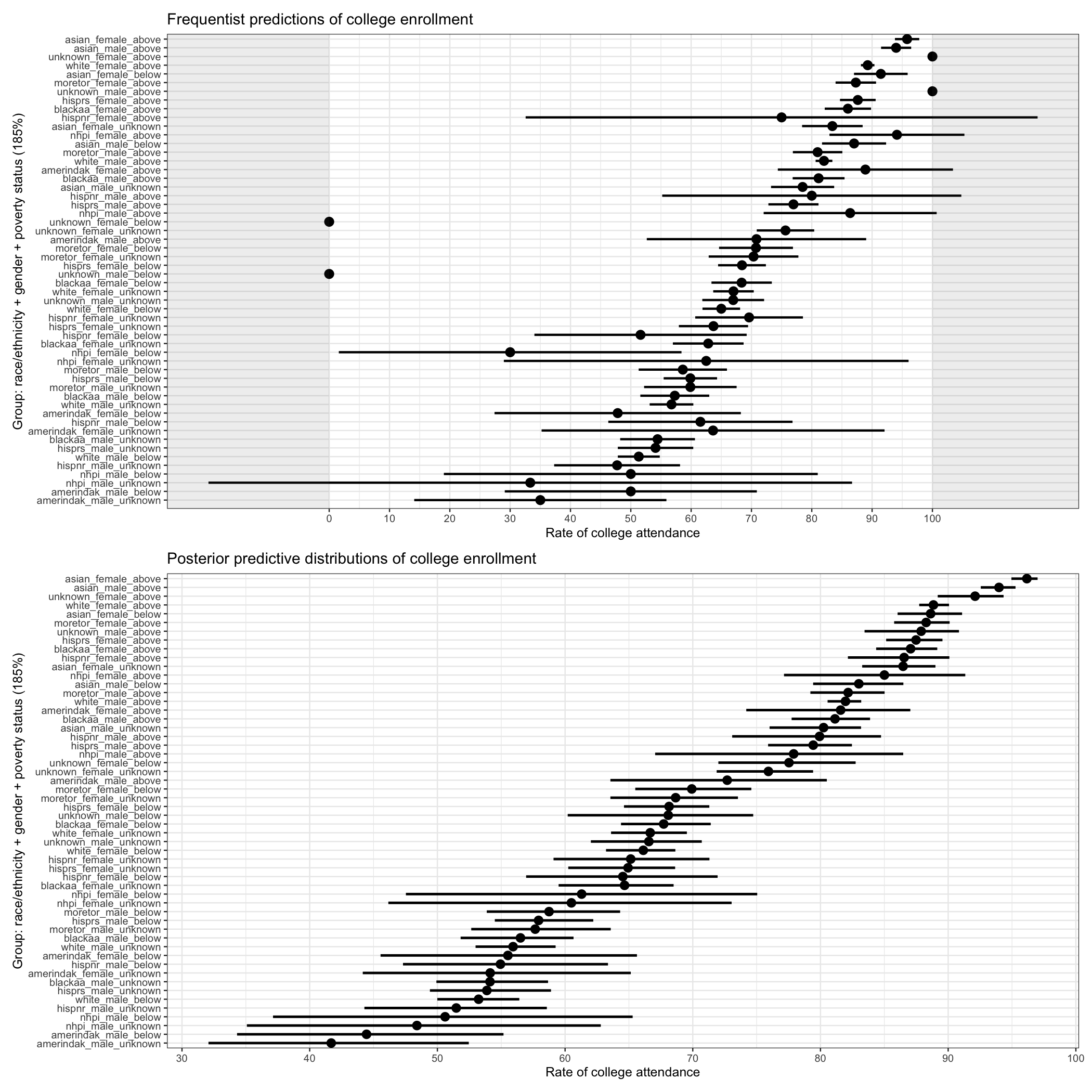
With this quick comparison, we can see a number of weaknesses of the frequentist approach:
- 95% confidence intervals are wider than Bayesian 95% credible intervals
- some 95% CIs cross 0 and 100%
- some groups don’t have estimates at all
Of course, a frequentist might (rightfully!) counter:
- we didn’t run a frequentist HLM
- our Bayesian estimates, especially for small groups, may be biased
Unfortunately, there isn’t a single determining factor that will tell us that one approach is better. That said, if one wants to provide estimates (with estimates of error) for small groups, a Bayesian approach provides options that a frequentist does not.
Comparing groups
Often in the course of analyses that investigates heterogeneity, we want estimates in the difference in effect between groups. In a frequentist analysis, we’ll often look to see if parameters are statistically different from one another (for example, their CIs don’t overlap) and then report the difference between the estimates. However, this is a bit of a statistical fudge because our estimates of error aren’t directly related to that difference. We can say pretty confidently that they are different, but with less confidence about the size of that difference. With Bayesian posteriors, we can simply subtract one from the other to create a posterior distribution of the difference.
We pause to note that statistical comparisons between groups are fraught. They have been (and sometimes still are) used to support deficit frameworks, in which one group is unfavorably compared to a second group that is set as a standard. By implication or outright statement, the first group is framed as lacking and/or at fault for the difference. Often, it is minoritized groups who are put in relation to a white standard, and differences along some dimension are denoted as a gap. Researchers must be careful not to fall into facile comparisons that, rather than elucidate important heterogeneity of experience, situate the outcomes of structural oppressions as the responsibility of individuals or groups.
Because Ben is presenting this portion of the workshop, our example focuses on the difference in college enrollments between white men below and above the poverty line. Other groups could equally and, in the context a full analysis and deeper connection to a particular critical theoretical framework, more fruitfully be explored. We encourage participants to modify the code and check other potential between group differences, keeping in mind critical theories that might elucide rather than reify those differences.
## -----------------------------------------------------------------------------
## comparison
## -----------------------------------------------------------------------------
## filter to two group comparison
pp_comp <- pp |>
filter(group %in% c("white_male_above", "white_male_below"))
## plot two groups to make comparison clearer
comp_g <- pp_comp |>
ggplot(aes(y = group, x = .epred)) +
stat_pointinterval(.width = 0.95, linewidth = 0.7, size = 1) +
scale_x_continuous(breaks = seq(0, 100, 5),
minor_breaks = seq(0, 100, 1)) +
labs(
title = "Posterior predictive distributions of college enrollment",
y = "Group: race/ethnicity + gender + poverty status (185%)",
x = "Rate of college attendance"
) +
theme_bw()
comp_g
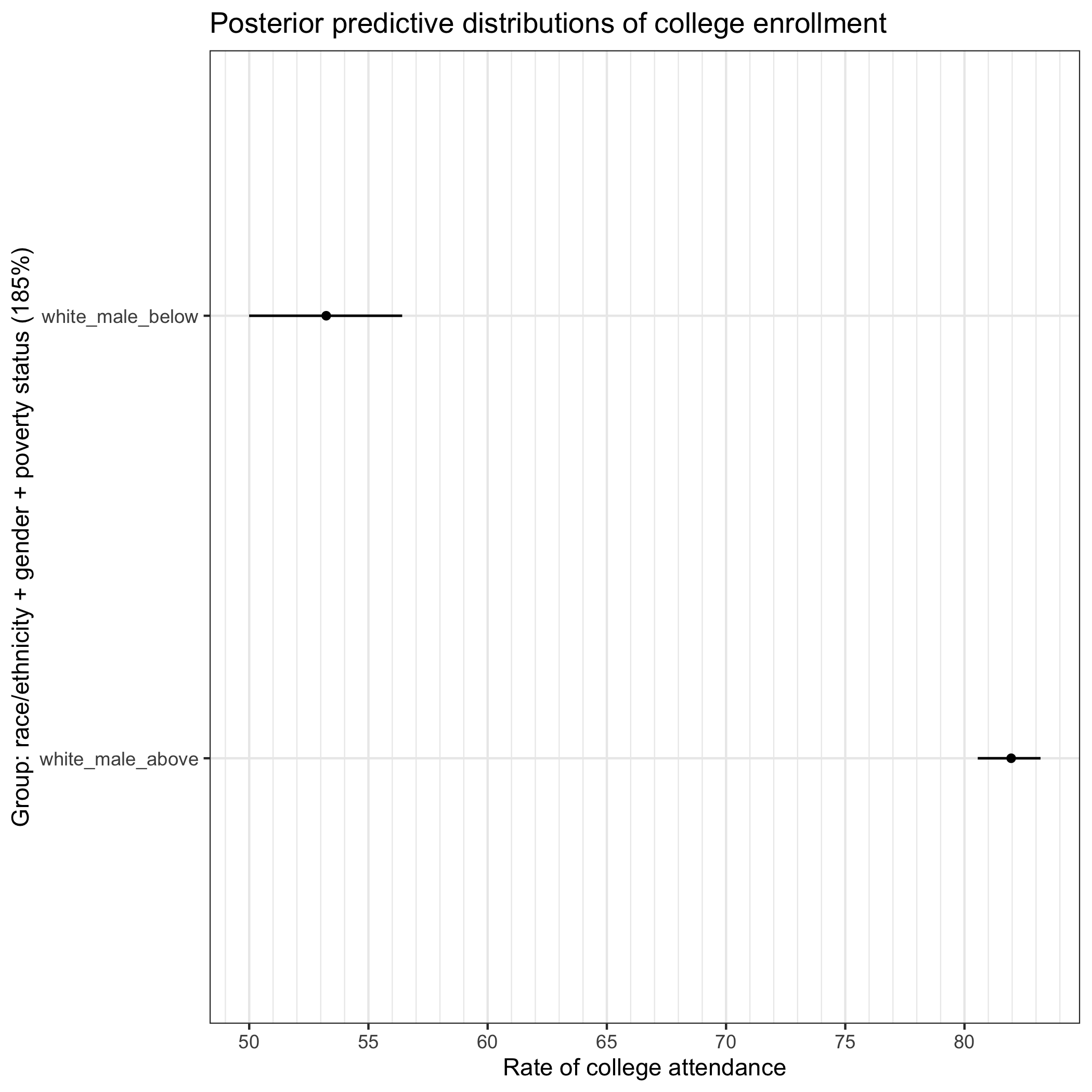
## wrangle data to subtract one group of predicitions from the other to get
## estimate of difference
pp_diff <- tibble(wma = pp_comp |> filter(group == "white_male_above") |> pull(.epred),
wmb = pp_comp |> filter(group == "white_male_below") |> pull(.epred),
diff = wma - wmb)
## plot density of difference
diff_g <- pp_diff |>
ggplot(aes(x = diff)) +
geom_density() +
geom_vline(xintercept = pp_diff$diff |> mean(), linetype = "dashed") +
scale_x_continuous(breaks = seq(0, 100, 1),
minor_breaks = seq(0, 100, 0.5)) +
labs(
title = "Difference in attendance rates",
subtitle = "(White, male, above 185%) - (White, male, below 185%)",
y = "Density",
x = "Percentage point difference"
) +
theme_bw()
diff_g

We can see that the difference in enrollment rates among white men below the 185% poverty line are about 29 percentage points less likely to enroll in college than their white male peers above the poverty line. With this approach, we can put a range on this estimate of about 25 to 33 percentage points. This is an important difference in enrollment rates by income, and one that underlies much student aid policy. However, this comparison is only one of many potential comparisons and cannot be fully unpacked in the absence of theory.
Wrapping up
We have flown through this introduction to Bayesian analyses. Participants and those following along after the workshop likely have many questions. One key question is: how does this relate to QuantCrit or other critical frameworks? This is a fair question because, as we said we would, we focused more on the technical aspects of Bayesian analysis than the critical applications. To repeat: a Bayesian analysis does not make one’s work critical. In fact, all that we did today could largely be done theory-free or with a non-critical approach. It is the deep engagement with critical frameworks that would make the work critical.
Our hope, at the end of the lesson, is that participants now have a better understanding of poorly understood quantitative framework that might be usefully used alongside critical frameworks in quantitative work. Bayes is not a panacea — participants should rightly note this — but it does provide alternate avenues for critical quantitative work that otherwise are closed through frequentist paradigms. At the very least, Bayes provides another viewpoint on quantitative work that might elucidate what a QuantCrit or critical quantitative scholar hopes to accomplish with their work, regardless of whether they use Bayes at all.